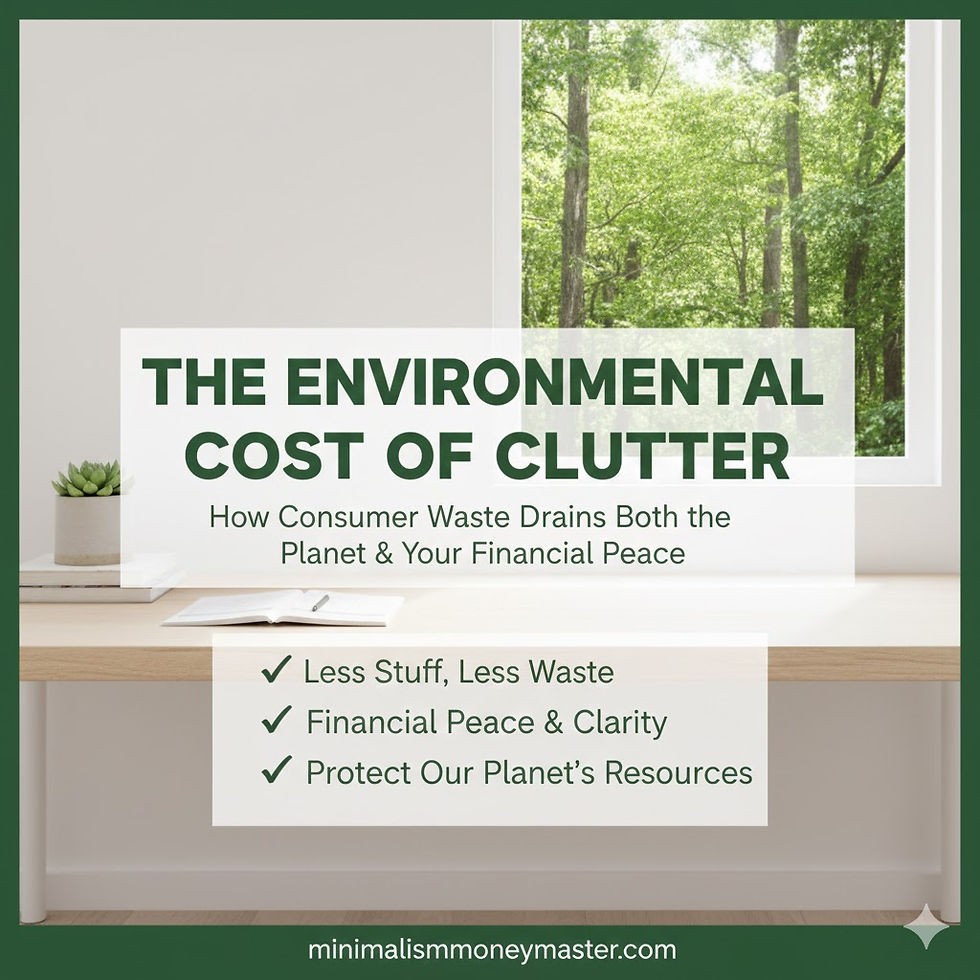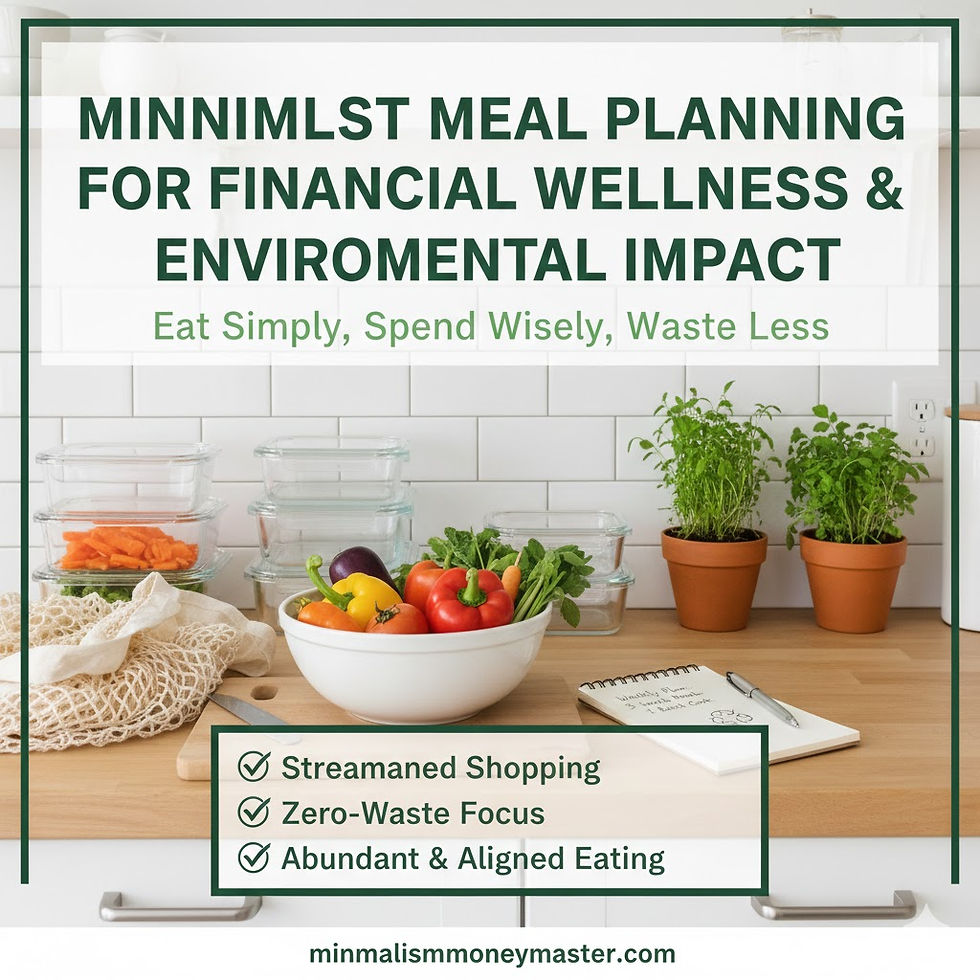Tiny Homes and Minimalist Wealth: Integrating Housing, Lifestyle, and Long-Term Financial Strategy
- jennifercorkum
- Oct 22
- 6 min read
Tiny homes are often discussed in isolation — as a quirky lifestyle choice, a housing hack, or a DIY adventure. But from a minimalist finance perspective, they’re far more than that.
Tiny homes can become a strategic financial lever — one that touches housing costs, investment strategy, lifestyle design, and long-term wealth building.
The real power of tiny homes emerges when you integrate them into your broader financial and life strategy, rather than treating them as a one-off project. In other words: it’s not just about building a small house. It’s about building a big-picture system that supports freedom, resilience, and simplicity.
This post will explore how to bring tiny homes into the heart of a minimalist financial plan — aligning housing, investing, and life design for sustainable, long-term wealth.
Why Integration Matters More Than Aesthetics
Minimalism is often misunderstood as “owning less stuff.” In reality, it’s about clarity, intentionality, and systems thinking. You don’t just strip away; you rebuild intentionally.
Tiny homes often start with lifestyle aspirations — freedom from clutter, closer connection to nature, a simpler daily rhythm. But without a clear financial integration strategy, many tiny home projects risk becoming expensive hobbies rather than strategic assets.
Some common examples of misalignment:
Building a $120,000 custom tiny home without a clear ROI or payoff plan.
Placing a tiny home on land that can’t legally support it long-term.
Treating tiny homes purely as rental cash machines without considering taxes, maintenance, or zoning.
Moving into a tiny home but not redirecting the savings toward investments — resulting in lower expenses but stagnant wealth.
Integration matters because a tiny home’s financial impact depends on how it fits into everything else you’re doing.
Step 1: Position the Tiny Home Within Your Financial Independence Framework
For many minimalist investors, the ultimate goal is financial independence (FI) — the ability to cover living expenses indefinitely through investments, savings, or low-stress income. Housing is a core pillar in that equation.
A tiny home can support FI in three powerful ways:
1. Reducing Core Living Expenses
Lower mortgage (or none), reduced utilities, smaller insurance bills, and minimal maintenance = lower “required income.” This directly reduces the FI number (the total amount you need to retire early or live off investments).
For example, if your traditional housing expenses are $2,000/month and a tiny home brings that down to $700/month, that’s $1,300/month in savings. Over a year, that’s $15,600 — which, if invested, compounds into hundreds of thousands over a couple of decades.
2. Accelerating Savings and Investment Contributions
Tiny home living often frees up a significant portion of income. That extra capital can be diverted to index fund investing, real estate, or business building.
The minimalist principle here is simple: channel savings into compounding assets, not lifestyle creep.
3. Creating Optionality
Tiny homes give you a lower-cost “base”. This means you can:
Take career risks without fear of losing your home.
Transition to part-time work earlier.
Travel or live seasonally while renting out your tiny home.
Weather economic downturns with a lower burn rate.
In the FI community, optionality is a form of wealth. Tiny homes create it by lowering fixed costs and increasing flexibility.
Step 2: Integrate Tiny Homes With Your Investment Strategy
Minimalist finance emphasizes simplicity and long-term compounding. A tiny home can either:
Complement your investment strategy, freeing up capital to grow elsewhere, or
Be part of the investment strategy itself, through rentals or appreciation.
A. Using Tiny Homes to Free Capital
This is the simplest model. You live in a tiny home, keep expenses low, and invest the difference in:
Broad index funds (e.g., ETFs tracking S&P 500 or global markets).
Dividend or infrastructure funds.
Other real estate opportunities.
Your own business or creative projects.
The tiny home doesn’t need to generate direct returns — it simply unlocks more investment capacity by lowering your cost of living.
Minimalism thrives on clean separation of functions. Housing keeps you grounded. Investments grow quietly. Both work together, not against each other.
B. Tiny Homes as Investment Assets
Some owners treat tiny homes as cash-flowing properties:
Airbnb/short-term rentals.
Long-term rental units (especially as ADUs in urban lots).
Seasonal relocation rentals (e.g., renting while traveling).
This can work extremely well — especially because tiny homes often have high yield-to-cost ratios compared to traditional real estate. But it must be systematic, not improvised:
Understand zoning and permitting.
Run conservative cash flow projections.
Include vacancy rates and maintenance in your calculations.
Treat it like a business, not a hobby.
C. Balanced Hybrid Strategy
You don’t have to choose between living in your tiny home or renting it out. Many minimalists build hybrid strategies, such as:
Living in the tiny home part of the year, renting it the rest.
Placing it on land with room for a second unit, creating dual income streams.
Moving the tiny home seasonally to optimize cost of living and rental yield.
Integration means seeing the tiny home as part of the portfolio, not separate from it.
Step 3: Align Tiny Home Choices With Lifestyle Design
Financial minimalism isn’t just about numbers — it’s about lifestyle design. Tiny homes shine when they support the life you want, not the life you’re escaping.
Ask yourself:
Do I want geographic flexibility or a permanent home base?
Am I comfortable with ultra-small living long-term, or is this a 5–10 year strategy?
Do I want to manage rentals, or prefer a hands-off investment strategy?
What does an “ideal day” look like, and does a tiny home bring me closer to it?
For example:
If you value mobility and adventure, a tiny home on wheels paired with remote work might be ideal.
If stability and passive income are priorities, a permanent tiny home on a rental property might be better.
If your goal is aggressive wealth building, living small and investing the difference is the cleanest path.
Minimalist finance works best when your financial systems mirror your real lifestyle priorities, not social trends.
Step 4: Build Exit Strategies and Flexibility Into the Plan
One of the most overlooked elements of tiny home planning is the exit strategy. Life changes — careers shift, families grow, health needs evolve. A good minimalist financial plan acknowledges this upfront.
Ask:
How easily could I sell or relocate this tiny home if my plans change?
Does my financing structure allow me to pivot without penalties?
If I rent it out, what are the management or legal implications?
Could the home be repurposed (e.g., guest house, ADU, rental unit) later?
Flexibility isn’t a lack of commitment — it’s strategic resilience. It keeps your minimalist system from becoming rigid or fragile.
Step 5: Avoid Integration Pitfalls
Many well-intentioned tiny home owners fall into traps that undermine their financial goals:
❌ Treating the tiny home as a standalone decision. Without connecting it to investments or FI goals, its impact is limited.
❌ Over-investing in customization. A $130,000 “tiny mansion” erodes ROI and flexibility.
❌ Ignoring local laws. Zoning or utility issues can destroy an otherwise solid plan.
❌ Failing to redirect savings. Lower costs only help if you actually invest the difference, not spend it.
❌ Underestimating lifestyle shifts. Tiny living isn’t for everyone long-term — plan accordingly.
Minimalism is about intention, not restriction. Avoiding these pitfalls keeps your tiny home strategy lean and effective.
Bringing It All Together
A tiny home, on its own, is just a structure. But when you integrate it with your financial independence framework, investment strategy, and lifestyle design, it becomes a powerful wealth-building tool.
It reduces costs dramatically.
It frees capital for investing and wealth accumulation.
It supports flexibility, career shifts, and intentional living.
It can generate income if structured strategically.
It aligns your financial systems with your real priorities.
This integration is where minimalist finance shines: simple, strategic, and sustainable over decades.
Final Thought
Tiny homes are not just a housing trend — they’re a financial architecture opportunity. They give you a chance to rewire your housing, investing, and lifestyle systems in a way that prioritizes freedom over excess, clarity over complexity, and long-term resilience over short-term appearances.
Minimalism isn’t about shrinking your life. It’s about expanding your freedom by stripping away financial clutter.A well-integrated tiny home strategy is one of the most powerful ways to do just that.







Comments